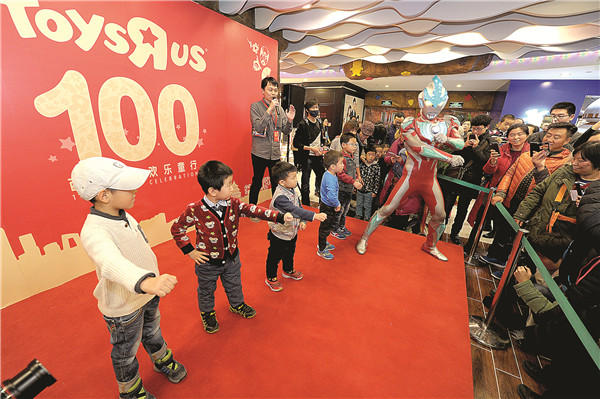 |
|
Children play with toys at Toys "R" Us outlet in Beijing. CHINA DAILY |
"We consider Asia, particularly China, to be a very important region for future growth. The factory in Jiaxing is a testament to that belief. It will enable us to better react to consumer demand across the region as well as China," said Lego in an e-mail to China Daily.
Lego Group's turnover was DKK14.14 billion ($2.11 billion) in the first half of 2015, driven by double-digit growth across all geographical regions and strong product innovation on themes, according to its financial report.
"While all our regions experienced double-digit growth, it is particularly satisfactory that Asia saw the highest growth rate, given the considerable investments we are making there to further the company's globalization," said Loren Shuster, Lego's executive vice-president and chief commercial officer .
Despite Chinese children's liking for video gaming, Lego construction toys retained their appeal even though they are costlier than local brands such as BanBao and Cogo, said Wei of Euromonitor.
Better quality, safer brick materials and clearly printed construction instructions resulted in their rising sales to Chinese consumers.
Lego has integrated Chinese elements into its construction toys and undertaken continual research and development efforts to design exclusive products for Chinese consumers, according to Wei.
Despite reports that two of the world's leading toymakers, Mattel Inc and Hasbro Inc, may merge, the two have made no comments on the subject so far.
Mattel's brands include the iconic Barbie dolls, Hot Wheels and Matchbox cars, Fisher-Price toys and American Girl Brands products. Hasbro makes toy figures like Transformers and G.I. Joe, and Littlest Pet Shop, Nerf and Play-Dohs, and games such as Monopoly, Scrabble and Twister.
According to Euromonitor International, in 2014, Mattel, ranked No 4, had only a 1.3 percent share of the China market, while Hasbro, ranked No 7, had a 1 percent share.
So, any Mattel-Hasbro merger will likely have implications for the toys market in China.
But, many top international toymakers have not focused intensively on China. Those that have found their global success strategies didn't always work in China.
For instance, Mattel's first Barbie flagship store, called Barbie Shanghai, opened in 2009. The six-story store held the world's largest and most comprehensive collection of Barbie dolls and licensed Barbie products.
However, in 2011, Mattel shut the Shanghai store because it, contrary to expectations, failed to arouse a rapid and strong demand from children, said Wei.
Market consensus was that Barbie had not blended well with Chinese culture.
In China, Barbie was just a new doll to most Chinese children. Few children really knew or cared what Barbie stood for. Worse, Barbie's appearance looked foreign, Wei said.
Yet, in 2014, Barbie remained the leading brand in dolls and accessories worldwide. But it continued to lose market share to local brands in China, Wei said.
Second-ranked Kurhn and third-ranked Lelia were the more adaptive brands, not only because of their Chinese heritage but because they were affordable.
Globally, Mattel and Hasbro's dominance has been challenged by rising new brands such as Lego. The former's iconic products failed to attract new consumers.
In its 2015 financial report released on Feb 1, Mattel said its worldwide sales were up 1 percent but Barbie sales fell 1 percent. Hasbro's net revenue in 2015 rose by 4 percent to $4.45 billion.
